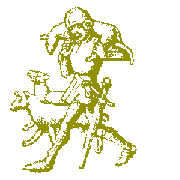| SOME NOTES ON MEDIEVAL ENGLISH GENEALOGY | ||||
| HOME | GUIDE | SOURCES | FAMILIES | RESOURCES |
| LINKS | CALENDAR |
Request updates WHAT'S NEW |
THIS SITE | SEARCH |

Medieval monarchs were frequently desperate for money, and devised a bewildering variety of taxes to raise it. This activity left behind a huge residue of detailed records, which are potentially a mine of information for genealogists. Moreover, although for obvious reasons the rich were taxed most heavily and most often, on occasions taxation extended right to the lowest levels of society.
The largest accumulation of taxation records is in class E 179, traditionally known as the 'subsidy rolls', produced between the 12th and the 17th centuries. An online listing of the records, the E 179 Database, is in progress (it currently covers more than 25,000 documents, with records of lay taxation in five English counties complete). It can be searched by place, date and other categories, and gives descriptions of the records, lists of places covered, and details of published texts, but does not include transcripts of the names mentioned in the documents. A published work covering taxation records in E 179, Lay Taxes in England and Wales, 1188-1688, has also been produced, which includes a detailed chronological listing of all the taxes levied, the political circumstances which gave rise to them, and the administrative procedures for their collection.
Taxes were raised in many different ways. Earlier land taxes - including carucage, feudal aids, scutage and tallage - are discussed in a separate section. In the early 13th century a new variation - the subsidy based on a fraction of the value of moveable goods - was developed, and went on to become a mainstay of medieval taxation. Initially, the fraction varied with each assessment, but from 1334 the process was simplified by fixing the sums required from each community at the amounts that had been levied in 1332. These were based on one fifteenth for rural and one tenth for urban areas and the royal demesne. The tax was therefore known as a fifteenth and tenth from that time until its abolition in the 17th century. The poorest inhabitants, and also the counties of Cheshire and Durham, were exempt, and few returns have survived before 1294. In addition, after the system was reformed in 1334, names of individual taxpayers were not returned to the Exchequer (except for Kent and Sussex). Nevertheless, valuable returns survive for the intervening period, listing for each county the taxpayers and the amounts for which they were assessed. Many of those for the 1332 assessment have been printed.
Another device for raising money, employed from the mid-14th century onwards, was the forced loan (known in later Tudor times as the privy seal loan). These 'loans' were usually voluntary in theory - although refusal could be very difficult, and might result in imprisonment - and were often never repaid. They varied in their scope, but often only the wealthier members of society were invited to contribute.
In contrast, the three poll taxes levied between 1377 and 1381 embraced the whole adult population, both male and female - only beggars were exempted. Many returns have survived, the most detailed being those of 1379, in which occupations were often stated. On the other hand, these returns are less complete than those of 1377 because - just as in the 20th century - there was widespread evasion of the poll tax. In addition, some of the 1381 assessments were destroyed in the ensuing Peasants' Revolt. The experiment was not repeated for several hundred years.
The surviving poll tax returns have been printed in full in Carolyn Fenwick's The Poll Taxes of 1377, 1379, and 1381 (1998-2005).
In the fifteenth century, in parallel with the continuing use of fifteenth and tenths and forced loans, a succession of subsidies was levied, essentially based on landed income, but often also with an element of taxation on moveables. Under the Tudors, the sophistication of both the method of assessment and the administrative procedure increased, and a larger proportion of the population became liable, though evasion later became widespread. The survival of the earlier returns is uneven, but from 1523 a fairly complete series survives, the fullest being those of 1524 and 1525. A number of those from the first half of the 16th century have been printed.
Available online:
Also available online:
Published works:
| Public records: Common law records > |